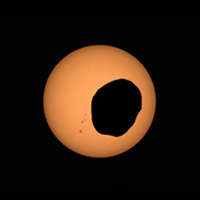NASA’s Perseverance rover recorded the best video ever of a solar eclipse from Mars
posted Friday, April 22, 2022 at 10:30 AM EST

Heading to Mars may seem like a strange way to celebrate Earth Day, but a new video from NASA's Perseverance rover is as good a reason as any to visit the Red Planet virtually. The Perseverance rover recently sent back footage of one of a solar eclipse featuring one of Mars's two moons, Phobos.
While the larger of the two moons, Phobos is still small compared to our moon – it's about 157 times smaller than Earth's moon. Mars's other moon, Deimos, is even smaller. The eclipse was captured on April 2, the 397th Martian day (sol) of the Perseverance mission and lasted around 40 seconds. The spectacular event was captured using the Mastcam-Z camera and delivered the most zoomed-in, highest frame-rate video of an eclipse from the Martian surface.
Previous images and videos were much less detailed and offered a more distant view of the eclipse. In 2004, two NASA rovers, Spirit and Opportunity, recorded the first time-lapse photos of Phobos during a solar eclipse. They also recorded Deimos during an eclipse a few days prior, although it looks like a speck in front of the sun. In 2019, Curiosity, which is still hard at work on Mars, captured two more solar eclipses.
Rachel Howson, who works at Malin Space Science Systems in San Diego and is one of the Mastcam-Z operators for Perseverance, knew that the latest eclipse video would be good. She and the rest of the team saw thumbnails first, as the rover doesn't instantly transmit full-resolution video back to Earth. 'I knew it was going to be good, but I didn't expect it to be this amazing,' said Howson. 'It feels like a birthday or holiday when [full-resolution videos] arrive. You know what's coming, but there is still an element of surprise when you get to see the final product.'
The new video is distinguished by not only its detail and framerate, but also by its color. Mastcam-Z includes a solar filter that reduces the sun's intensity, allowing us to see more detail of Phobos's unusual shape. 'You can see details in the shape of Phobos' shadow, like ridges and bumps on the moon's landscape,' said Mark Lemmon, a planetary astronomer with the Space Science Institute in Boulder, Colorado. Lemmon has organized most of the Phobos observations by Mars rovers. 'You can also see sunspots. And it's cool that you can see this eclipse exactly as the rover saw it from Mars.'
Phobos is currently on a death spiral. Every year, it gets a bit closer to the Martian surface, and one day, likely in tens of millions of years, it will finally crash into the surface. Eclipse footage helps scientists better understand Phobos's steady descent. Despite its small size, the moon has a tangible impact on Mars's surface. NASA's Jet Propulsion Laboratory writes, 'As Phobos circles Mars, its gravity exerts small tidal forces on the Red Planet's interior, slightly deforming rock in the planet's crust and mantle. These forces also slowly change Phobos' orbit. As a result, geophysicists can use those changes to better understand how pliable the interior of Mars is, revealing more about the materials within the crust and mantle.'
(Via The Verge)